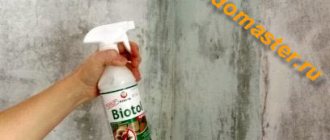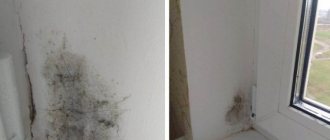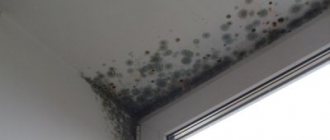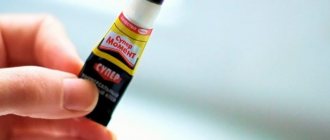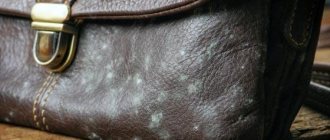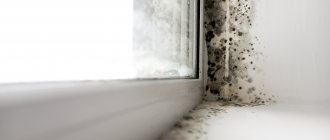Many homeowners are faced with the problem of mold on the ceiling. It usually accompanies the appearance of fungus on the ceiling and walls.
Mold on the ceiling is not a reason to make repairs if one was not planned.
But it’s really not so easy to deal with it, because it’s not enough to just clean the surface; It is also necessary to destroy the spores inside the base. How and with what can you remove mold from the ceiling in an apartment with your own hands at home?
Instructions
If the mold stain is small, use a putty knife or a stiff wire brush. Wipe off the mold. Pay attention to safety precautions - be sure to use a cotton-gauze bandage or a respirator. Make sure there are no children around you. Mold pores are very dangerous for children's bodies!
Prepare a solution of copper sulfate or bleach solution. Carefully treat areas where mold is present. To avoid poisoning from chlorine fumes, treatment should be carried out in a well-ventilated area.
If the ceiling is deeply damaged by mold fungus, carefully remove the layer of plaster with a spatula. Treat with bleach solution as described above. After the solution has completely dried, apply a new layer of plaster and paint over it.
If the fungus has settled on your ceiling for a long time, you can purchase a mold repellent (anti-fungal solution) at a hardware store. Please note that some preparations not only destroy mold, but also bleach the ceiling. When using these products, you should first remove visible mold with a spatula or brush and only then apply an antifungal composition to the stain. There are times when it is impossible to do without chemicals. This is, for example, an aqueous solution. The concentration of the anti-mold agent in it depends on the degree of damage to the surface. Dilute the powder in water according to the instructions. Be careful! Be careful not to get the product into your eyes! Carefully apply it to the ceiling - directly to the fungus. Wait the time specified in the instructions and remove the mold with a spatula or brush. Rinse the affected area with water. The room should be ventilated.
For preventative purposes, pour a chlorine-containing solution into a spray bottle and spray areas on the ceiling where mold may appear. It is enough to carry out this treatment once a month.
To prevent mold from appearing on the ceiling in the bathroom, you should constantly ventilate the room. Make sure that moisture does not accumulate on the ceiling. Install a small fan in the ventilation duct. Paint the ceiling with water-based paint.
Video on the topic
Fungus on the ceiling surface is a serious problem in the home. Many people try their own ways to get rid of this trouble, however, the situation only gets worse. Of course, ideally you need to get rid of the fungus immediately when its first traces appear on the wall.
Unfortunately, few people pay attention to the various molds that are just beginning to develop. The reproduction of these single-celled organisms occurs very quickly, so the situation will only get worse every day. Unfortunately, the fungus can appear almost anywhere, so very often it is found in places that are constantly outside of human vision.
It should be noted that fungus appears especially often in rooms where the relative humidity is significantly increased. If we are talking about humidity, which is 95%, then there will be a large amount of fungus in such a room, and the residents themselves will feel discomfort.
There are other reasons for the appearance of fungus.
- Very often, fungus on the ceiling appears in those rooms that are regularly flooded from above. Water gets into the cracks between the bathtub and the wall, and waterproofing can very rarely save the situation. It will take a very long time for the ceiling to dry out after such a nuisance.
- Heating and water supply risers can also be a serious cause of fungus. The steel pipes of these elements can become significantly leaky. Accordingly, moisture spreads quite rapidly.
- Often, problems of this kind arise due to outdated sewage systems, which begin to leak and create an unfavorable atmosphere in the room. Therefore, it is worth regularly monitoring the integrity of all installations and pipes.
- Condensation is also a serious problem and the cause of fungus on the ceiling. Similar phenomena occur in cases where the water in a steel pipe is much colder than the surrounding air. The moisture will condense and the residue will flow onto the floor.
- Often fungus appears due to freezing of walls. This case can be called common for the reason that many people have quite low temperatures in their homes in winter.
- Fungus can also form on ceilings due to non-functional or insufficiently efficient ventilation. It is very easy to check the functionality of the ventilation. Just light a match and bring it to the ventilation opening. If the flame shakes a little and then goes out, everything is fine with ventilation. In other cases, it is necessary to carry out certain measures aimed at restoring the functionality of ventilation.
We can also talk about the obvious reasons for the appearance of fungus.
It could even be wet spots. If the main ceiling is hidden behind a tension covering, you should get rid of the fungus as quickly as possible, if it is present. Otherwise, microorganisms will negatively affect the health of the residents of the house, as well as the integrity of building structures.
What to do to prevent mold from forming on the ceiling
There are many ways to remove mold, but it is easier to do everything to ensure that it does not even appear.
To prevent mold from growing in your home, follow these guidelines:
- ventilate the room in a timely manner;
- organize a well-thought-out ventilation system;
- do not dry clothes inside the house - do it outside, even in winter;
- do not allow even minor leaks in water pipes to appear in the house;
- repair ventilation ducts in the bathroom in a timely manner;
- If you decide to renovate your home, make sure that all the materials necessary for these purposes are moisture resistant.
It is worth noting that for fungus to form in a room, the humidity must exceed 80% at a temperature within 20 °C. Therefore, always, if you feel that the humidity in the room is starting to rise, immediately begin to ventilate it.
Prevention of fungus
Nowadays, there are a large number of products, the use of which guarantees the absence of fungus and other microorganisms in the future. First of all, it is worth noting the antiseptic primer. Regular treatment of walls and ceilings with such products will allow you to forget about fungus in the foreseeable future.
The best solution would be to use antiseptic primers during construction activities. It is especially important to use such a primer in cases where it is planned to install suspended and suspended ceilings. The cost of such antiseptics is low, so this remedy for fungus on the ceiling is the most optimal.
If the fungus has already appeared on the surface of the ceiling, you will have to use completely different means.
- First of all, we will need to remove all plaster and whitewash that is affected by fungus. Only the floor slabs should remain. You can first wet the ceiling, and after just a couple of ten minutes, all the plaster will be removed as easily as possible.
- If there is peeling plaster on the same ceiling, you should also get rid of it.
- Now we will have to return to the antiseptic primer again. It should be applied to the ceiling surface with a brush. It is important not to miss any affected area. We will need to get into every hole and scratch, otherwise the fungus will soon begin to form again.
- After the antiseptic primer has dried, it’s time to apply a bitumen primer to the ceiling surface. This is also a primer, however, it will help strengthen the previous layer and make the plaster layer durable.
- Using acrylic putty, we will need to seal all the protrusions and recesses. After everything has dried, you can start painting the surface.
- However, it is also worth noting that the ideal solution would be to sand the surface of the wall. This will reduce the appearance of fungus to a minimum.
- If you have a suspended ceiling at home, you can limit yourself to only an antiseptic primer.
If you are not interested in such a long and expensive way to solve the problem, you can limit yourself to buying Whiteness.
This is a product that perfectly resists fungus, and is also inexpensive. Whiteness is based on sodium hypochloride, a caustic substance that can easily resist bacteria. This product can be used to treat the affected area, after which the fungus will disappear.
However, it should be understood that the substance is quite dangerous to human health, so all operations with Whiteness should be carried out with rubber gloves and goggles. Unfortunately, this product does not protect the surface from fungus for long. In just a few weeks you will need to apply Whiteness to the ceiling again.
From this we can conclude that only the full range of actions described above can help get rid of the fungus for a long time. Otherwise, we sacrifice the presentable appearance of the home. You should also seriously analyze the situation and find the source of the fungus; this determines whether the fungus will appear in the future.
Knowing how to remove mold from the ceiling and other parts of the room will be useful for any person. After all, probably every housewife has encountered the appearance of this fungus at home, settling in damp places, especially in the bathroom and kitchen.
Methods to get rid of this scourge
Over a long time, people have come up with many ways to rid themselves of such a neighbor. But not all of them have proven their effectiveness.
To completely get rid of the fungus, you will need to mechanically clean all affected areas of the ceiling or other surfaces. You will need to not only wipe all the black spots with a rag, but also completely remove the layer of coating affected by this infection.
If it is not possible to remove the affected area, or the infection has penetrated very deeply, you should try to remove as much of the infected coating as possible.
In the interpanel joints, if they are not properly insulated, a void may form through which cold air will penetrate. This leads to cooling of the hay and condensation of moisture on it. Next are the already known consequences. Therefore, the seams need to be sealed in the summer.
Residents of the upper floors must inspect their ceiling. If there are signs of mold, it is necessary to check how well the roof is waterproofed and eliminate the cause of condensation on the ceiling.
There are also “folk” means of eliminating mold. The most effective of these types of remedies turned out to be simple preparations available in every home.
- Hydrogen peroxide. It destroys fungus on the ceiling or walls perfectly. But how many bottles of it will be needed to treat a large area?
- Bleach "Whiteness". The product works well against mold and is found in most homes. You can buy a large bottle that is enough to cover a large space. Relatively inexpensive.
- Ammonia. More suitable for local use on small affected areas. And its main drawback will be the disgusting smell. Few people can stand such a stench in the house.
- Regular soda. Every housewife has it in her kitchen. You can make a solution and treat the fungus-affected areas with it. The method is not the most effective, but sometimes it helps.
After this, it’s the turn of chemistry. The stores sell a fairly large assortment of all kinds of impregnations and products for removing fungal infections from surfaces.
All the necessary chemicals can be purchased at any hardware store, since they are all used when performing repairs.
First of all, it is an antiseptic impregnation for coatings. It will destroy existing fungal spores and prevent its reappearance in the future. The surface is treated according to the instructions from the packaging.
The primer used to treat ceilings before painting also works. There are primer compositions without bactericidal additives; it is better not to use them. This primer will protect the ceiling from the appearance of black spots for a long time.
How dangerous is the fungus and why does it appear?
Mold is a very tenacious organism. It actively spreads microscopic spores around itself, and even when it seems that it has finally been gotten rid of, these spores are waiting for favorable conditions to begin to actively reproduce again.
Mold gradually eats away not only plaster and paint, but also even very strong concrete structures, as a result of which they gradually crumble, and in the worst case, they may collapse at some point. In addition to the fact that fungus spoils the appearance of the room and destroys some materials, it creates a musty smell in the room and can lead to lung infections and allergic reactions.
The main condition for mold to grow is dampness. Fungal spores are present almost everywhere, but in a dry room they do not multiply, and in a damp room a couple of weeks will be enough for an ugly black spot of fungus to spread across the wall, ceiling or furniture.
Obviously, the bathroom in any case remains the dampest place in the apartment, nothing can be done about it. But this is often aggravated by poor ventilation, leaking pipes, dripping taps and other additional sources of moisture.
Prevention measures
It is not enough to destroy a fungal colony once; it is important to create conditions for mold that are unfavorable for its reappearance.
- A heated towel rail helps dry the air in the bathroom. If a water dryer is not initially provided, you can install an electric one yourself and turn it on as needed.
- If one of the walls borders the staircase, then it should be additionally insulated to avoid constant condensation.
- All cracks and crevices in walls and ceilings must be sealed as soon as they are discovered to prevent water vapor and mold spores from accumulating there.
- It is also important to maintain all pipes and taps in good condition so as not to create excess moisture.
If all the plumbing in the apartment is in working order, the air is relatively dry, and there is still mold on the ceiling, then the problem may be a faulty pipe in the neighbors on the floor above.
Dangers of each type
There are always mold spores in the air, but they begin to develop only under favorable conditions. It can appear on concrete, brick and other surfaces and be black, green or blue.
Types of mold:
- black mold , its type depends on the stage of development;
- white mold on walls is rare, it is often confused with efflorescence, but if you pick it up in your hands, it will knead and the efflorescence will crumble;
- blue , it affects wooden surfaces;
- actinomycetes are a cross between algae and fungi; they also infect wooden objects;
If we talk about a person’s reaction to mold, it can be divided into the following groups:
- Allergic , it is especially dangerous for people with diseases of the respiratory system and is often the cause of allergic rhinitis.
- Pathogenic , it can cause various diseases, healthy people with strong immunity usually cope with it, but children, the elderly and people with weak immunity can develop diseases such as pneumonia, bronchitis, etc. It forms gray and black colonies.
- Toxic species can cause serious complications, and even death. Problems caused by such mold can be in the form of irritation, other symptoms and even lead to the development of cancer.
Mold spores can enter the human body through the air, during breathing, through the skin or through food.
The most common diseases that arise from exposure to mold are asthma, pneumonia, other respiratory diseases, upset stomach, various skin rashes, and headaches.
With prolonged exposure to pathogenic species, a person may develop internal bleeding, kidney, liver, and lung diseases. When mold enters the human body, it is called mycosis; for diagnosis, it is necessary to contact a specialized laboratory.
How to fight fungus?
What to do if mold appears on the bathroom ceiling? In the most advanced cases, a radical remedy may be required - remove all furniture and equipment from there, remove coverings, and thoroughly dry the room with a powerful hair dryer.
After this, it is necessary to apply antifungal agents. As a rule, they are quite harmful to the body, so work should be carried out in a protective suit. After the impregnation has completely dried, you can make repairs in the room.
But what to do if the bathroom renovation was done quite recently and you don’t want to repeat it at all? Is there any way to get rid of mold on the ceiling without harming the fresh finish? Yes, you can.
- Mold can be removed from smooth surfaces such as tiles with any detergent and a hard sponge. With porous surfaces, everything is more complicated, because the fungus penetrates deep into the structure of the material.
- Any chlorine-containing preparations are effective against fungus. This can be chlorine bleach (bleach, by popular name), powders like Comet, or special, very aggressive anti-mold agents like Dufa. But the chlorine compounds in these products are very harmful to the body, so it is better to work with gloves, protect your eyes with goggles, and your nose and mouth with a respirator or at least a thick cloth.
- Chlorine-free household chemicals are less harmful to humans and pets, but their effectiveness is significantly less, so they are mainly used as a preventive measure.
- Ammonia is considered a fairly effective remedy. It is diluted in approximately equal proportions with water, applied to the affected areas for several hours and washed off with water. However, in the hope of greater effectiveness, you should never mix ammonia with chlorine-containing products, since their reaction releases toxic substances.
- Vinegar is another good way to get rid of fungus in the bathroom, while being completely harmless to humans. Apply undiluted white vinegar to the affected area with a cloth or spray, leave for an hour or two, then wipe with a clean cloth and dry. Another safe but very effective remedy is borax (a weak salt of boric acid - sodium tetraborate). It is used in solution - 1 glass of dry product per 2-3 liters of water. Apply to the surface with a brush.
- Hydrogen peroxide, despite its completely harmless chemical composition, also helps get rid of mold quite well. Undiluted peroxide is applied to the surface in any convenient way. Since the product has a whitening effect, before using it on colored surfaces it is worth testing it in an inconspicuous place on the ceiling.
- A few tablespoons of baking soda (sometimes with vinegar added) dissolved in a glass of water is a safe way to remove fungus. The solution is applied with a spray; if necessary, the surface of the ceiling is rubbed with a brush or a stiff sponge, then all dirt is wiped off.
- A natural antiseptic that mold is very afraid of is tea tree oil. A few drops are dissolved in a cup of water and sprayed onto the affected area without rinsing. The product can fight not only the mold itself, but also the accompanying smell of dampness and mustiness. However, the oil should be used with caution if there are people with allergies in the house.
- Also a potentially allergenic, expensive, but very effective remedy is citrus seed extract (oranges, grapefruits, lemons).
If mold appears on seams sealed with sealant, it is better to remove it, treat the area, dry thoroughly, and then use a sealant with antifungal additives.
Drying the surface
After applying the antiseptic to the mold-affected base, it is necessary to ensure that it dries completely. For this, conventional ventilation is most often used. Next, you need to dry the entire ceiling very well, for which additional units such as a heat gun or household heater are used. Only complete removal of residual moisture will guarantee that the fungus will not appear again.
A completely dry and cleaned base will require decorative finishing. It is best to use one of the hanging systems, which will simply block the surface prone to “blooming” from visual viewing. In this regard, tension systems and lining (preferably plastic) have proven themselves very well. The latter option is well suited for wet rooms, because... the base base will be well ventilated.
